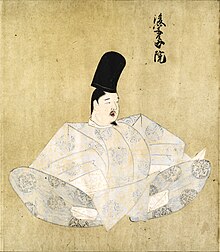Go-Uda
| Go-Uda | |
|---|---|
| Emperor of Japan | |

Go-Uda
|
|
| Reign | 1274–1287 |
| Predecessor | Kameyama |
| Successor | Fushimi |
| Born | December 17, 1267 |
| Died | July 16, 1324 (aged 56) |
| Burial | Rengebu-ji no Misasagi (Kyoto) |
Emperor Go-Uda (後宇多天皇 Go-Uda-tennō) (December 17, 1267 – July 16, 1324) was the 91st emperor of Japan, according to the traditional order of succession. His reign spanned the years from 1274 through 1287.
This 13th-century sovereign was named after the 9th-century Emperor Uda and go- (後), translates literally as "later"; and thus, he is sometimes called the "Later Emperor Uda," or, in some older sources, may be identified as "Emperor Uda, the second" or as "Emperor Uda II."
Before his ascension to the Chrysanthemum Throne, his personal name (imina) was Yohito (世仁).
He was the second son of Emperor Kameyama. They were from the Daikakuji line.
Yohito-shinnō became crown prince in 1268. According to the terms of the late emperor's will (Go-Saga died in 1272), in 1274, he would become emperor upon the death or abdication of Emperor Kameyama.
The retired Emperor Kameyama continued to exercise power as cloistered emperor.
During his reign, the unsuccessful Mongol invasions of Japan occurred, first in 1274 and again in 1281. Though they established a beachhead at Hakata, Kyushu, they were driven out within a short time.
In 1287, retired Emperor Go-Fukakusa, dissatisfied with the fact that his own lineage (the Jimyōin-tō) did not control the throne, while that of his younger brother, the retired Emperor Kameyama (the Daikakuji-tō) did, persuaded both the Bakufu and the imperial court to compel the Emperor to abdicate in favor of Go-Fukakusa's son (Emperor Fushimi).
After this time, the struggle between the Jimyōin-tō and the Daikakuji-tō over the imperial throne continued. After Go-Uda's abdication, his Daikakuji-tō controlled the throne from 1301 to 1308 (Emperor Go-Nijō) and again from 1318 until the era of northern and southern courts (begun 1332) when they became the southern court (ending in 1392).
...
Wikipedia
